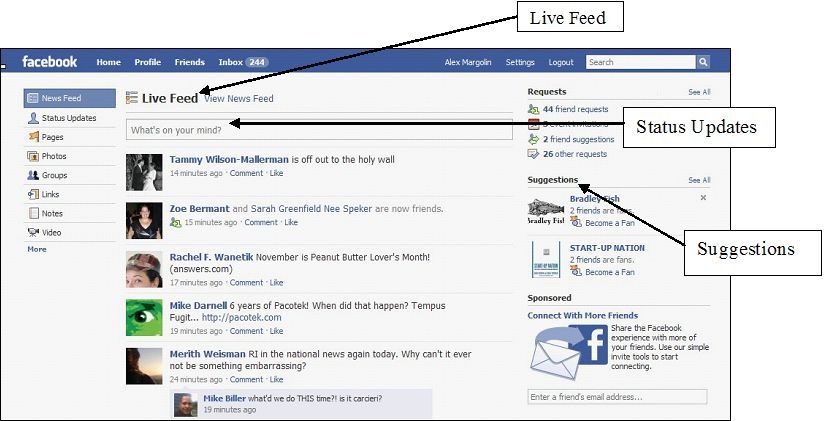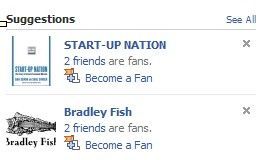 With 325 million members across the world, including a whopping 130 million who are active daily, social network Facebook has become the giant of social media. And the site continues to add half a million new users every day. Initially created to help college students connect to one another, the site has broken through all age barriers and social groups to become on of the largest sites on the Internet. In fact, Facebook’s own statistics show that the fastest growing demographic on the site is people 35 and older.
With 325 million members across the world, including a whopping 130 million who are active daily, social network Facebook has become the giant of social media. And the site continues to add half a million new users every day. Initially created to help college students connect to one another, the site has broken through all age barriers and social groups to become on of the largest sites on the Internet. In fact, Facebook’s own statistics show that the fastest growing demographic on the site is people 35 and older.
Facebook’s extraordinary reach makes it one of the Internet’s most effective platforms for spreading information, planning events, and sharing content such as photos, videos, and articles of interest. Even organizations with their own websites (including HonestReporting) have recognized the importance of maintaining a presence on Facebook as part of their online strategy.
Information spreads through Facebook in a process similar to word-of-mouth. When a person registers to attend an event, for example, the information goes out to that persons entire network. The announcement then functions as a personal endorsement for the event. It is much more effectively than a banner ad or a general announcement. Friends learn about the event through their trusted network, increasing the chances that they may attend. In that way, information about the event moves from friend to friend, across numerous networks.
People also join groups about specific issues or become “fans” of organizations or businesses. These groups and fan pages allow people to interact with others who are interested in similar issues, broadening their personal networks and increasing their influence.
The following is a short guide to some of Facebook’s basic functions to help people utilize the site easily and effectively. This guide will also show how information spreads through the site to allow activists to use the most effective channels to promote their message.
GETTING STARTED ON FACEBOOK
In order to begin making Facebook “friends” and sharing content, users must perform a one-time registration. Although the site will allow you to create a detailed profile, users are only required to provide their names, email addresses, a password, their gender, and their birth date. Everything else is optional. A profile photo, however, is highly recommended.
Once the registration is complete, the fun begins. In subsequent visits, you may be asked to sign in using your email address and password, though Facebook will remember the login information for a short period. To find friends, simply type their names in the search box in the top right corner. When you go to their profile page, you will see a box offering to add the person as a friend. If you click on the box, a request will be sent to the person asking for a confirmation. Facebook will also offer recommendations based on your profile information and friends you may have in common with other friends.
STATUS UPDATES, LIVE FEEDS, AND SUGGESTIONS
Once you become someone’s friend on Facebook, their “status updates” and activities will appear on your “Live Stream” and your updates will appear on theirs. Here is a picture of what you might see when you login to Facebook:

Near the top of the middle column, there is a box that asks you, “what’s on your mind?” That box is your window to the world on Facebook. What you write will appear on your friends’ Facebook pages. You can write a thought, post a link to an article, or post a photo or video and all of your friends will see it. What you write or post is called a Status Update.
According to Facebook’s statistics, the average user has 120 friends. Since no two people have the same list of Facebook friends, every time an article, photo, or video appears, it reaches a new group of people. Therefore, if you see something your friend posted that you believe deserves a wider audience, post it in your own status update. And when you post content that other people find particularly compelling, they are likely to repost it themselves, keeping the content moving across networks.
Directly below the status update box is the Live Feed. It is made up of Status Updates from your friends, including activities such as groups they have joined, Pages they have become fans of, friends they have added, and events they plan to attend. The Live Feed allows you to stay up-to-date with your friends and discover content that may be of interest.
On the right side of the page, there is a section called “Suggestions.” When a number of friends join the same group or become fans of a similar organization or individual, Facebook will often draw your attention to it. Here is a close-up of what might appear in the Suggestions section:
 The Suggestions section is one of the most important elements in the viral spread of information on Facebook. When someone launches a campaign around a particular issue and many of their friends join, all of their friends can see the swirl of activity around the issue. When people see their personal friends joining, they are much more likely to visit the group to learn more, increasing the probability that they will join themselves.
The Suggestions section is one of the most important elements in the viral spread of information on Facebook. When someone launches a campaign around a particular issue and many of their friends join, all of their friends can see the swirl of activity around the issue. When people see their personal friends joining, they are much more likely to visit the group to learn more, increasing the probability that they will join themselves.
GROUPS AND PAGES
Groups and Pages are effective tools for spreading information and generating discussion around a topic. Both function in a similar manner. The difference between them is that anyone can start a group on any issue or topic but a fan Page can only be opened by an official representative of a business or organization. In other words, anyone can start a group focusing on anti-Israel bias in the media. But only a representative from HonestReporting can open a fan page for HonestReporting.
HonestReporting has its own Page to keep supporters updated on our activities and to create a space for people to interact with one another. There are currently more than 3,000 fans for the Page, many of whom make their voices heard through comments on the material whenever we add new content. Everything we post on the Page appears in the Live Feed for all of the members.
The
HonestReporting Page also serves as a platform for reposting our material. According to Facebook, the average user has 120 friends. So if just 2% of our 3,000 fans repost our reports in their own status updates, those 60 people will reach an additional 7,200 people. If another 0.5% of that total repost the same material, those 36 people will extend to more than 4,300 people, bringing the total to well over 14,000 people, simply by posting a link to our Page.
Those numbers will continue to grow as more people become fans of the Page. And every time new people join, all of their friends can see it, raising the possibility that even more people will join.
So while our fan Page serves as a hub for our Facebook activities, we also open groups to address particular issues. Our successful campaign to force Facebook to recognize Golan residents as Israelis began with a Facebook group called Facebook, Golan Residents Live in Israel, Not Syria. The group attracted some 2,500 members within weeks and drew attention from pro-Israel bloggers. Ultimately, Facebook changed its settings.
Facebook makes it easy to start a group, so if you feel strongly about an issue, let the Facebook community know about it. You never know what it takes to change the world.
TAPPING FACEBOOK’S ENORMOUS POTENTIAL
 As a social network connecting an unprecedented number of people, Facebook stands at the forefront of the social media universe. The site contains features that help people stay informed of their friends’ activities, allowing information to move quickly from friend to friend and from network to network. For online activists, there are 325 million reasons to get involved.
As a social network connecting an unprecedented number of people, Facebook stands at the forefront of the social media universe. The site contains features that help people stay informed of their friends’ activities, allowing information to move quickly from friend to friend and from network to network. For online activists, there are 325 million reasons to get involved.
In addition to the basics above, there are numerous other features that allow people to express themselves and have their voices heard by large numbers of people. Start by getting comfortable with the site’s basic structure, then explore the functions to see what else you can use.
And don’t forget to join HonestReporting’s own Page to stay on top of all of the media bias issues. We look forward to cooperating with you in the future. And check out part one in this series if you haven’t already seen it.

